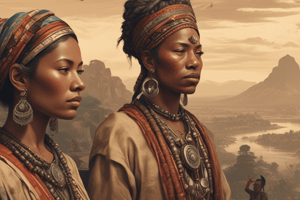Podcast
Questions and Answers
What is the main reason why individuals from modern societies are unlikely to obtain similar physical capabilities as those found in traditional hunter-gatherer populations?
What is the main reason why individuals from modern societies are unlikely to obtain similar physical capabilities as those found in traditional hunter-gatherer populations?
- They do not have the same cultural need or opportunity to specialize in such physical activities. (correct)
- They do not have the same genetic makeup as those in traditional populations.
- They do not have the same physical training regimes as traditional populations.
- They do not have access to the same high-calorie diets as traditional populations.
What does the text suggest about the frequency of individuals exhibiting extraordinary physical capabilities within traditional populations?
What does the text suggest about the frequency of individuals exhibiting extraordinary physical capabilities within traditional populations?
- Such capabilities are found with equal frequency in both traditional and modern populations.
- Such capabilities are found in the majority of individuals within these populations.
- Such capabilities are extremely rare and only found in a few select individuals.
- Such capabilities are found slightly more frequently in traditional populations than in modern societies. (correct)
What is the primary reason the text gives for why traditional populations are able to exhibit such extraordinary physical capabilities?
What is the primary reason the text gives for why traditional populations are able to exhibit such extraordinary physical capabilities?
- They have genetic adaptations that enable them to perform such feats.
- They have access to high-calorie diets that provide the necessary energy.
- They engage in physical labor and challenges as part of their daily existence. (correct)
- They have specialized training regimes that develop their physical abilities.
What does the text suggest about the idea that traditional populations can complete such physical feats without training?
What does the text suggest about the idea that traditional populations can complete such physical feats without training?
What is the main difference the text suggests between the training and physical activities of traditional populations compared to those in modern western societies?
What is the main difference the text suggests between the training and physical activities of traditional populations compared to those in modern western societies?
What is the key point the text makes about the physical capabilities of individuals within traditional hunter-gatherer populations?
What is the key point the text makes about the physical capabilities of individuals within traditional hunter-gatherer populations?
What does Physical Activity Level (PAL) refer to?
What does Physical Activity Level (PAL) refer to?
How does a PAL value below 1.4 get classified by the World Health Organization?
How does a PAL value below 1.4 get classified by the World Health Organization?
In the context of PAL, where would a value between 1.4 and 1.69 be classified?
In the context of PAL, where would a value between 1.4 and 1.69 be classified?
What is the classification for PAL values between 2.0 and 2.4 according to the World Health Organization's framework?
What is the classification for PAL values between 2.0 and 2.4 according to the World Health Organization's framework?
How does a PAL greater than 2.4 get categorized by the World Health Organization?
How does a PAL greater than 2.4 get categorized by the World Health Organization?
Why do Tarahumara children not have to take time away from their work/school to engage in exercises?
Why do Tarahumara children not have to take time away from their work/school to engage in exercises?
Why do Tarahumara children regularly outperform appropriate peer-comparison populations in a 10 mile course?
Why do Tarahumara children regularly outperform appropriate peer-comparison populations in a 10 mile course?
What advantage does using a standard measure of physical activity provide in understanding an evolutionarily normal level of physical activity?
What advantage does using a standard measure of physical activity provide in understanding an evolutionarily normal level of physical activity?
What is the significance of metabolic rate in determining an evolutionarily normal level of physical activity?
What is the significance of metabolic rate in determining an evolutionarily normal level of physical activity?
How does the societal need impact the physical abilities of children in different populations?
How does the societal need impact the physical abilities of children in different populations?
What impact does walking an average of ten miles a day have on Tarahumara children?
What impact does walking an average of ten miles a day have on Tarahumara children?
Which of the following health issues are not experienced by non-human great apes?
Which of the following health issues are not experienced by non-human great apes?
How many hours do non-human great apes typically spend sleeping and engaging in sedentary or light activities?
How many hours do non-human great apes typically spend sleeping and engaging in sedentary or light activities?
What anatomical change is mentioned as a key factor in reducing energetic needs and allowing early humans to forage over larger areas?
What anatomical change is mentioned as a key factor in reducing energetic needs and allowing early humans to forage over larger areas?
Based on the information provided, how far do non-human great apes typically walk or climb in a day?
Based on the information provided, how far do non-human great apes typically walk or climb in a day?
Which of the following statements is true regarding the activity levels of modern humans compared to hunter-gatherer populations and non-human great apes?
Which of the following statements is true regarding the activity levels of modern humans compared to hunter-gatherer populations and non-human great apes?
Which of the following is NOT mentioned as a factor that influenced the early origins of hunting and gathering?
Which of the following is NOT mentioned as a factor that influenced the early origins of hunting and gathering?
According to the passage, what is the main advantage of human bipedalism over quadruped locomotion in typical walking/jogging patterns?
According to the passage, what is the main advantage of human bipedalism over quadruped locomotion in typical walking/jogging patterns?
What is the primary reason suggested in the passage for the evolutionary shift towards bipedalism in humans?
What is the primary reason suggested in the passage for the evolutionary shift towards bipedalism in humans?
According to the passage, which of the following adaptations do humans possess that support endurance activity?
According to the passage, which of the following adaptations do humans possess that support endurance activity?
What does the passage suggest is the relationship between the behavioral bias to avoid excess activity and the selection for enhanced efficiency (i.e., endurance)?
What does the passage suggest is the relationship between the behavioral bias to avoid excess activity and the selection for enhanced efficiency (i.e., endurance)?
Which of the following is the most accurate summary of the key point made in the first paragraph?
Which of the following is the most accurate summary of the key point made in the first paragraph?
What is the main evidence presented in the passage to support the idea that the shift towards bipedalism may have been driven by selection for enhanced endurance?
What is the main evidence presented in the passage to support the idea that the shift towards bipedalism may have been driven by selection for enhanced endurance?




